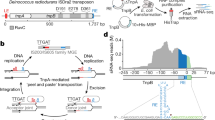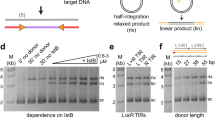Abstract
The insertion sequence IS1 belongs to a class of bacterial transposable genetic elements that can form compound transposons in which two copies of IS1 flank an otherwise non-transposable segment of DNA. IS1 differs from other known elements of this class (such as IS 10, IS 50 and IS 903) in several respects. It is one of the smallest known insertion elements1–3, exhibits a relatively complex array of open reading frames3, is present in the chromosomes of various Enterobacteria, in some cases in many copies4,5, and its insertion can result in the duplication of either 8 or 9 base pairs (bp) in the target DNA3. Furthermore, although, like other members of the compound class, it seems to undergo direct transposition, IS1 also promotes replicon fusion (co-integrate formation) at a relatively high frequency6. Like all other elements studied to date, the integrity of the extremities of IS1 are essential for efficient transposition7. We have constructed a test system to determine the minimal DNA sequences at the extremities of IS1 required for transposition. Sequential deletions of the end sequences reveal that 21–25 bp of an isolated extremity are sufficient for transposition. A specific sequence 13–23 bp from the ends, defining the edge of the minimal sequence, is implicated as an essential site. The sites, symmetrically arrayed at both ends of IS1, correspond to the apparent consensus sequence of the known binding sites for the Escherichia coli DNA-binding protein (called integration host factor or IHF) which is required for the site-specific recombination that leads to integration of bacteriophage λ into the bacterial genome8,9,26. The sites at the ends of IS1 may thus bind a host protein, such as JHF or a related protein, that is involved in regulating the transposition apparatus.
This is a preview of subscription content, access via your institution
Access options
Subscribe to this journal
Receive 51 print issues and online access
$199.00 per year
only $3.90 per issue
Buy this article
- Purchase on Springer Link
- Instant access to full article PDF
Prices may be subject to local taxes which are calculated during checkout
Similar content being viewed by others
References
Ohtsubo, E. & Ohtsubo, H. Proc. natn. Acad. Sci. U.S.A. 75, 615–619 (1978).
Johnsrud, L. Molec. gen. Genet. 169, 213–218 (1978).
Iida, S., Meyer, J. & Arber, W. Movable Genetic Elements (ed. Shapiro, J.) 159–221 (Academic, New York, 1983).
Ohtsubo, H., Nyman, K., Doroskiewicz, W. & Ohtsubo, E. Nature 292, 640–6543 (1981).
Nyman, K., Nakamura, K., Ohtsubo, H. & Ohtsubo, E. Nature 289, 609–612 (1981).
Galas, D. J. & Chandler, M. J. molec. Biol. 154, 245–272 (1982).
Machida, Y., Machida, C., Ohtsubo, H. & Ohtsubo, E. Proc. natn. Acad. Sci. U.S.A. 79, 277–291 (1984).
Friedman, D. J. et al. Microbiol. Rev. 48, 299–325 (1984).
Nash, H. A. & Robertson, C. A. J. biol. Chem. 256, 9246 (1981).
Johnson, R. C. & Reznikoff, W. S. Nature 304, 280–282 (1983).
Sasakawa, C., Carle, G. F. & Berg, D. E. Proc. natn. Acad. Sci. U.S.A. 80, 7293–7297 (1983).
Way, J. C. & Kleckner, N. Proc. natn. Acad. Sci. U.S.A. 81, 3452–3456 (1984).
Groenen, M. A. M., Timmers, E. & van de Putte, P. Proc. natn. Acad. Sci. U.S.A. 82, 2087–2091 (1985).
Maxam, A. & Gilbert, W. Meth. Enzym. 65, 499–560 (1980).
Machida, C., Machida, Y. & Ohtsubo, E. J. molec. Biol. 177, 247–267 (1988).
Craig, N. & Nash, H. Cell 35, 795–803 (1985).
Leong, J. M. et al. J. biol. Chem. 260, 4468–4477 (1985).
Lupski, J. R. & Godsen, G. N. Cell 39, 251–252 (1984).
Goosen, N. & van de Putte, P. Gene 30, 41–46 (1984).
Friedman, D. I., Olsen, E. J., Carver, D. & Gellert, M. J. Bact. 157, 484–489 (1984).
Hoyt, M. A., Knight, D. M., Das, A., Miller, H. I. & Echols, H. Cell 31, 565–573 (1982).
Miller, J. Experiments in Molecular Genetics (Cold Spring Harbor Laboratory, New York, 1972).
Chandler, M. & Galas, D. J. J. molec. Biol. 170, 61–91 (1983).
Maniatis, T., Fritsch, E. F. & Sambrook, J. Molecular Cloning: A Laboratory Manual (Cold Spring Harbor Laboratory, New York, 1980).
Prentki, P. & Krisch, H. M. Gene 29, 303–313 (1984).
Flamm, E. L. & Weisberg, R. A. J. molec. Biol. 183, 117–128 (1985).
Author information
Authors and Affiliations
Rights and permissions
About this article
Cite this article
Gamas, P., Galas, D. & Chandler, M. DNA sequence at the end of IS1 required for transposition. Nature 317, 458–460 (1985). https://doi.org/10.1038/317458a0
Received:
Accepted:
Issue Date:
DOI: https://doi.org/10.1038/317458a0
This article is cited by
-
Integration host factor bends the DNA in the Escherichia coli ilvBN promoter region
Molecular and General Genetics MGG (1990)
-
Expression of F transfer functions depends on the Escherichia coli integration host factor
Molecular and General Genetics MGG (1987)
-
Replication of pSC101: effects of mutations in the E. coli DNA binding protein IHF
Molecular and General Genetics MGG (1986)
Comments
By submitting a comment you agree to abide by our Terms and Community Guidelines. If you find something abusive or that does not comply with our terms or guidelines please flag it as inappropriate.



